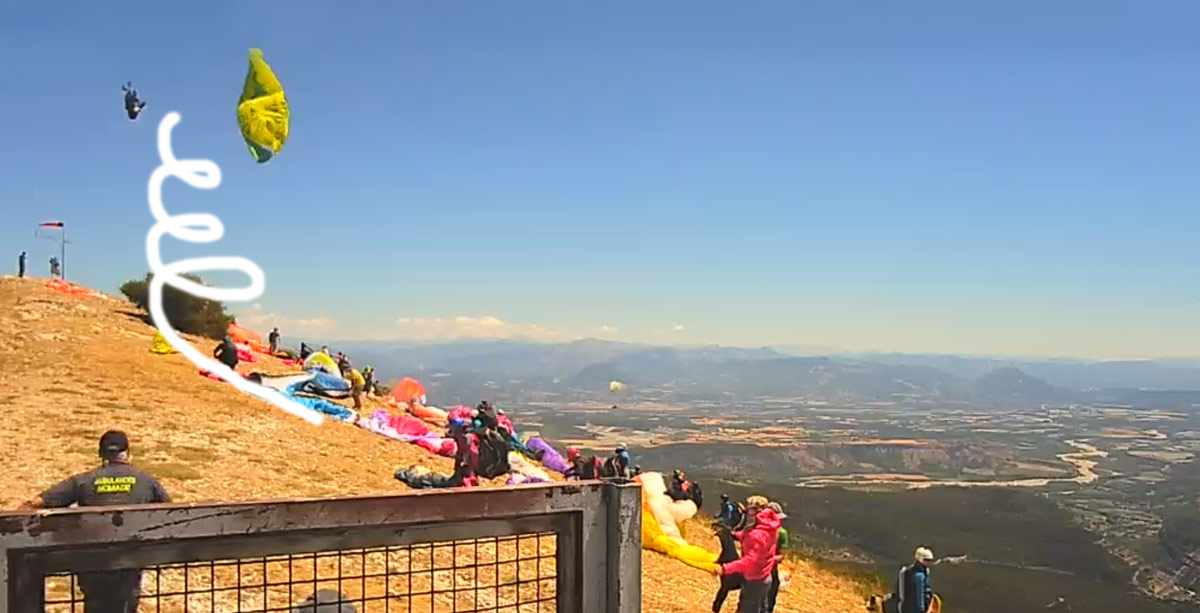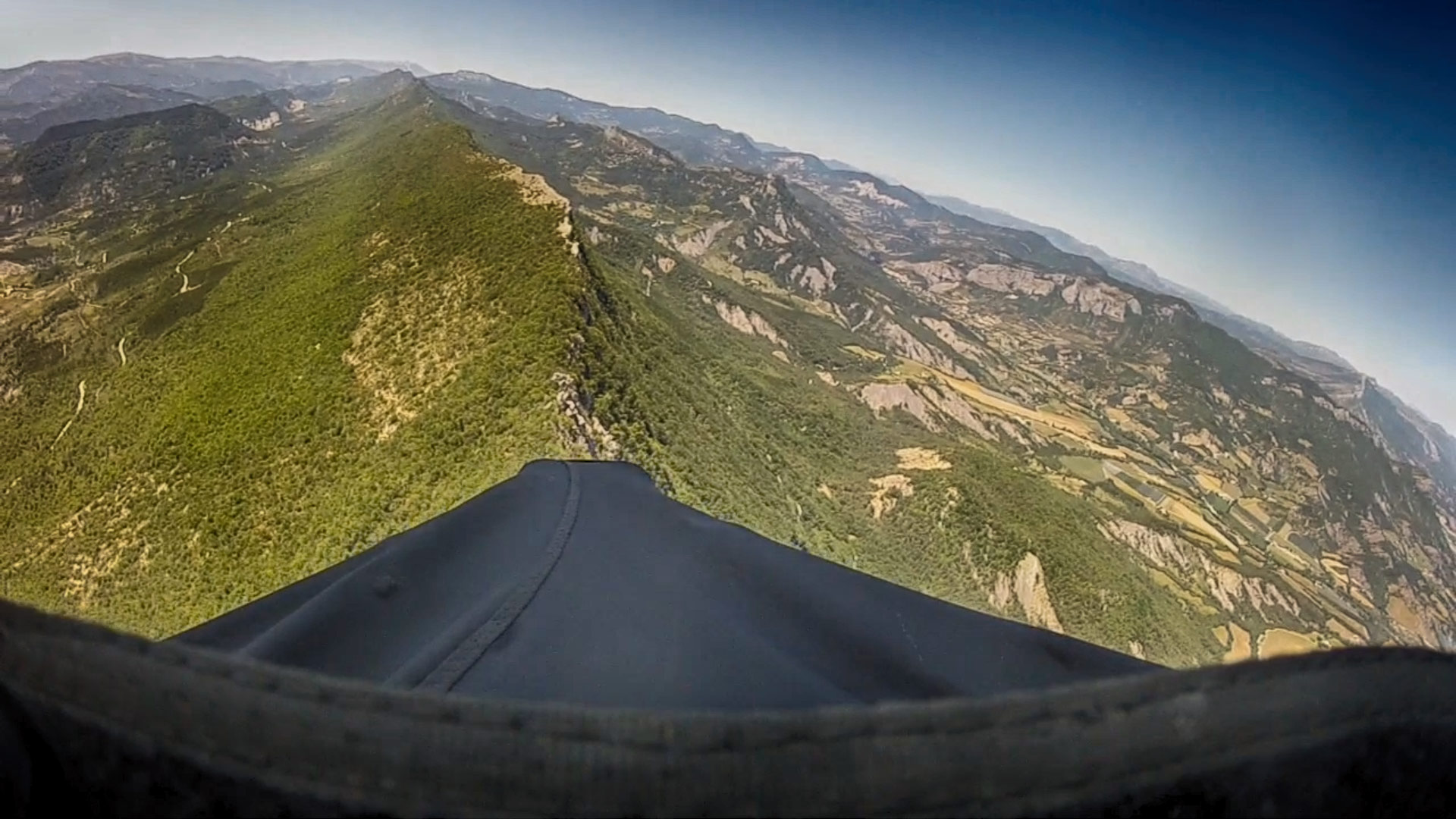
Flybubble crew member Boris Tyszko was attacked by a vicious dust devil this summer. He made a miraculous recovery and flew away. To understand what happened and how to avoid it, let's investigate dust devils and this incident in more detail.
What is a dust devil?
A dust devil is like a mini-tornado, a strong updraught that often creates a visible funnel of dirty air filled with dust and small debris. It shares a lot of characteristics with your common-or-garden thermal, but in the case of a dust devil the climb rate is extreme, the transition from lift to sink is violent, and the rotational energy is supercharged. All thermals have some rotational energy, but it is usually minor when compared to the upwards velocity. But when rotational energy is concentrated onto a narrower radius it speeds up. Like a rotating ice-skater that turns slowly with arms spread wide, but when she tucks her arms in she spins so fast you can't see her face.
How do dust devils form?
It must be possible to get the sudden vertical acceleration, and this needs a strong lapse rate right near the surface (think hot hot hot, going to cool). So it's unlikely to get a dust devil over a forest or vegetation, where the air temperature change will be more gradual. Open rocky patches are ideal. Dry surfaces heat faster, dark surfaces heat faster. Surfaces that are angled directly into the sun.
It must be possible for the air to rotate prior to liftoff, to begin to circulate. A dust devil is more likely to form where the air can feed into the thermal from different slopes, often found at the crest of ridges, over high points, all the places you'd usually look for thermals to trigger from.
Dust devils often sprout up just as the wind is just about to switch on launch. If you're launching from the lee side of a mountain, the general flow will create a low pressure area in the lee, which tends to encourage the formation of dust devils. Also it's possible that as the opposing airflow mixes higher up in the column it can reinforce the rotation of the dust devil, making the whole system more powerful and turbulent.
The common breeding spot to watch out for when cross country flying, is when the wind is angled across a slope. Every spine forms a mini-lee-side, where building thermals can pick up a nasty rotation, especially if that lee side is facing into the sun. When the thermal releases and accelerates upwards, this tightens the rotation into a narrower radius and you get a dust devil, which is often not visible as soil is washed away from steep slopes.
Enter Boris
Boris was attending the Ozone Chabre Open taking place on the Laragne launch. Despite the time of year of (midsummer) and time of day (13:20) conditions appear to be gentle, with many pilots boating around in moderate thermals, and the wind light up the front.
“I opened out my wing, got into my harness, did pre-flight checks and waited for pilots to get out of the way. I heard the dusty coming, asked a pilot to hold my wing-tip but before he could get to it, the dusty was upon me.
I buried my brakes but it still inflated, pulled me forward and up towards my wing.
I have a split second memory of looking at my wing and seeing the ground behind it and the bush next to me on launch - I thought to myself 'that bush might actually break my fall'.
A split second later I'm falling past my lines and thud into my harness and recognised that familiar sound of my wing inflating.
I realise that I'm now flying with a 360 twist towards the lee-side of the spine back ridge at about 4 meters above launch.
I'm worried that I'm going to auto-rotate into the hill so letting go of the brakes I reach up and pluck some lines looking for my brightly colours brake lines, I make a mental note that my stabilo is too similar a colour to my brakes line. I feel the risers trying to untwist but I don't want to do that until I am away from the hill so I push against one of the set of lines with my wrist and find the brakes lines.

I then notice Jocky on the radio telling me that I have enough height to get back to the front of launch.
I start tugging on the left brake and the wing starts to turn, I can feel it trying to untwist. I watch for traffic and start flying out in front of launch. I can hear Jocky in my ear telling me to rehearse my untwist procedure mentally before committing to it.
I let go of the upper lines and the harness naturally untwists letting my legs get pulled apart by the centrifugal force - I have never known if that helps or makes it worse. [ed: with legs splayed out, you will rotate slower, if you are wanting to untwist tuck your limbs in and sit upright, the same as the ice skater mentioned above. If you over-rotate you might want to slow your rotation by splaying legs and arms.]

Once untwisted I reach for brakes, look around for traffic out of sight and then head along the ridge, while collecting my dangling video camera. I then proceeded to fly through two thermals without turning, swearing my head off at the disbelief of what had just happened.
I told myself not to think about it and to find that last thermal. I finally start thermaling, rather inefficient at first as mind keeps flicking back to my launch. After 10 minutes I'm thermalling well again and start focusing on the task. The rest of the flight was fantastic and managed to beat both my personal bests in distance and time, covering 78 km and landing 2 km short of goal - I had ran out of task time!

That night I had a disturbed night's sleep thinking about how close I was to a serious injury.
The next day was another great day's flying and by that evening my launch seemed like a distant memory. Getting back on the horse, focusing deeply on other things and not dwelling on what could have happened made me recover from this mentally and emotionally.
Copious amounts of ground handling, particularly the short hops while still facing my glider helped me comfortably deal with the twist. However, I knew little about dust devils and had done nothing to mitigate the incident from happening in the first place.”

Greg's analysis
When I first saw the video I went cold all over. I thought I was watching a friend dying, and when I look at the snapshot of the apex it still seems like some ridiculous Photoshop montage. That was the most unexpectedly violent dust devil I have seen in 25 years of flying – there's very little warning that such dust devils are embedded in such mild looking conditions. The speed with which it lofted Boris, and the severity of the pitch it created on such a benign wing is greatly unsettling to witness. My takeaway from this is that every time you step onto a launch site you must treat it as a dangerous environment.
A good habit to get into on any launch site is to pin your wing with both brakes and C risers while you wait. This gives you more command to stop the wing rising. The power can be further removed from an errant rising wingtip by running towards it before it yanks you.
Aim to be self-sufficient on any launch site. In the time it takes to ask someone for help to pin down your wing, and for them to understand, decide and respond, you can be standing on your wing yourself. The best place would be the centre of your trailing edge. It's the least important part of your wing if you're going to need to repair it. Just get your boot on it or drop down onto one knee and hold it down.
Once Boris' wing had started rising off the ground there was not much else he could have done. The wing seems to be lifted by its trailing edge, making control inputs rather useless, and Boris would not have been able to stop that dive with any amount of brake input. The wing dives so far because it has been thrown from extreme lift into extreme sink.

The way it reinflates, so fast, completely, with no cravats, straight into flying is a testament to the Gin Sprint Evo's good design, and it's why we promote the EN B class so strongly. Most pilots will be OK on higher rated wings most of the time, but really, in the long term, what matters is that you can walk away from surprises like this and have years of flying experiences.
From the moment of re-inflation, Boris handles the situation very well, not worrying about the twists but focusing instead on flying the wing, establishing a safe heading, getting clear space, and only then untwisting.
It would have been good to include a warning to the pilots before they kitted up on launch that it is a known feature of this area to get dust devils, to such an extent that there are rings on the hang glider launch to bolt the wings down to when dust devils strike.
It makes me think that when scratching above this kind of slope you could fly into something like this at any time, so it's always wise to leave good clearance – enough height to have a large collapse, lose height in a spiral turn, and recover. Any closer than that and you're playing a dangerous lottery. Get up, and get away from the rocks!
TOP TIP: If you hear a rustling, see wings being rolled over or shaken about, or someone shouts ‘Dust devil' run to the centre of your wing straight away and pin it down.

Twisted love
Round 'n round the dusty roared
it picked up cows; the bovines soared,
the tractors lifted from the field,
and rooftops spun, till high they wheeled,
nay! flocked across the sunny skies,
like giant spiralled butterflies.
Far away it came to me,
the splintered bits of memory.
Oh glorious Whirlwind, do not die -
the toilet-flusher of the sky.
© Greg Hamerton
Brought to you by Flybubble
Like what we do? The best way to thank and support us is to buy gear from us and recommend us to others. Review our service on Trustpilot and our products on Flybubble Shop. You can also subscribe to Flybubble Patreon. Thank you!

